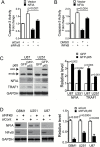A novel NFIA-NFκB feed-forward loop contributes to glioblastoma cell survival
- PMID: 27994064
- PMCID: PMC5473440
- DOI: 10.1093/neuonc/now233
A novel NFIA-NFκB feed-forward loop contributes to glioblastoma cell survival
Abstract
Background: The nuclear factor I-A (NFIA) transcription factor promotes glioma growth and inhibits apoptosis in glioblastoma (GBM) cells. Here we report that the NFIA pro-survival effect in GBM is mediated in part via a novel NFIA-nuclear factor-kappaB (NFκB) p65 feed-forward loop.
Methods: We examined effects of gain- and loss-of-function manipulations of NFIA and NFκB p65 on each other's transcription, cell growth, apoptosis and sensitivity to chemotherapy in patient-derived GBM cells and established GBM cell lines.
Results: NFIA enhanced apoptosis evasion by activating NFκB p65 and its downstream anti-apoptotic factors tumor necrosis factor receptor-associated factor 1 (TRAF1) and cellular inhibitor of apoptosis proteins (cIAPs). Induction of NFκB by NFIA was required to protect cells from apoptosis, and inhibition of NFκB effectively reversed the NFIA anti-apoptotic effect. Conversely, NFIA knockdown decreased expression of NFκB and anti-apoptotic genes TRAF1 and cIAPs, and increased baseline apoptosis. NFIA positively regulated NFκB transcription and NFκB protein level. Interestingly, NFκB also activated the NFIA promoter and increased NFIA level, and knockdown of NFIA was sufficient to attenuate the NFκB pro-survival effect, suggesting a reciprocal regulation between NFIA and NFκB in governing GBM cell survival. Supporting this, NFIA and NFκB expression levels were highly correlated in human GBM and patient-derived GBM cells.
Conclusions: These data define a previously unknown NFIA-NFκB feed-forward regulation that may contribute to GBM cell survival.
Keywords: NFκB; apoptosis; chemoresistance; glioblastoma (GBM); nuclear factor I-A (NFIA).
© The Author(s) 2016. Published by Oxford University Press on behalf of the Society for Neuro-Oncology. All rights reserved. For permissions, please e-mail: journals.permissions@oup.com
Figures






Similar articles
-
Nuclear factor I A promotes temozolomide resistance in glioblastoma via activation of nuclear factor κB pathway.Life Sci. 2019 Nov 1;236:116917. doi: 10.1016/j.lfs.2019.116917. Epub 2019 Oct 12. Life Sci. 2019. PMID: 31614149
-
A novel tumor-promoting role for nuclear factor IA in glioblastomas is mediated through negative regulation of p53, p21, and PAI1.Neuro Oncol. 2014 Jan;16(2):191-203. doi: 10.1093/neuonc/not167. Epub 2013 Dec 4. Neuro Oncol. 2014. PMID: 24305710 Free PMC article.
-
The microRNA-302b-inhibited insulin-like growth factor-binding protein 2 signaling pathway induces glioma cell apoptosis by targeting nuclear factor IA.PLoS One. 2017 Mar 21;12(3):e0173890. doi: 10.1371/journal.pone.0173890. eCollection 2017. PLoS One. 2017. PMID: 28323865 Free PMC article.
-
Phenotypic Spectrum of NFIA Haploinsufficiency: Two Additional Cases and Review of the Literature.Genes (Basel). 2022 Nov 30;13(12):2249. doi: 10.3390/genes13122249. Genes (Basel). 2022. PMID: 36553517 Free PMC article. Review.
-
NFκB function and regulation in cutaneous T-cell lymphoma.Am J Cancer Res. 2013 Nov 1;3(5):433-45. Am J Cancer Res. 2013. PMID: 24224122 Free PMC article. Review.
Cited by
-
Exploring Multi-Target Therapeutic Strategies for Glioblastoma via Endogenous Network Modeling.Int J Mol Sci. 2025 Apr 1;26(7):3283. doi: 10.3390/ijms26073283. Int J Mol Sci. 2025. PMID: 40244148 Free PMC article.
-
ASCL1 regulates neurodevelopmental transcription factors and cell cycle genes in brain tumors of glioma mouse models.Glia. 2020 Dec;68(12):2613-2630. doi: 10.1002/glia.23873. Epub 2020 Jun 23. Glia. 2020. PMID: 32573857 Free PMC article.
-
MiR-212-3p inhibits cell proliferation and promotes apoptosis by targeting nuclear factor IA in bladder cancer.J Biosci. 2019 Sep;44(4):80. J Biosci. 2019. PMID: 31502558
-
Prognostic significance of NFIA and NFIB in esophageal squamous carcinoma and esophagogastric junction adenocarcinoma.Cancer Med. 2018 May;7(5):1756-1765. doi: 10.1002/cam4.1434. Epub 2018 Mar 25. Cancer Med. 2018. PMID: 29577671 Free PMC article.
-
Single-cell multi-omics sequencing uncovers region-specific plasticity of glioblastoma for complementary therapeutic targeting.Sci Adv. 2024 Nov 22;10(47):eadn4306. doi: 10.1126/sciadv.adn4306. Epub 2024 Nov 22. Sci Adv. 2024. PMID: 39576855 Free PMC article.
References
-
- Central Brain Tumor Registry of the United States. CBTRUS Statistical Facts Primary brain and other CNS tumor diagnosed in the United States in 2009–2013. www.cbtrus.org.
-
- Stupp R, Hegi ME, Mason WP, et al. European Organisation for Research and Treatment of Cancer Brain Tumour and Radiation Oncology Groups; National Cancer Institute of Canada Clinical Trials Group Effects of radiotherapy with concomitant and adjuvant temozolomide versus radiotherapy alone on survival in glioblastoma in a randomised phase III study: 5-year analysis of the EORTC-NCIC trial. Lancet Oncol. 2009;10(5):459–466. - PubMed
-
- Sanai N, Berger MS. Glioma extent of resection and its impact on patient outcome. Neurosurgery. 2008;62(4):753–764; discussion 264–266. - PubMed
-
- Keles GE, Chang EF, Lamborn KR, et al. Volumetric extent of resection and residual contrast enhancement on initial surgery as predictors of outcome in adult patients with hemispheric anaplastic astrocytoma. J Neurosurg. 2006;105(1):34–40. - PubMed
MeSH terms
Substances
LinkOut - more resources
Full Text Sources
Other Literature Sources
Medical
Research Materials

